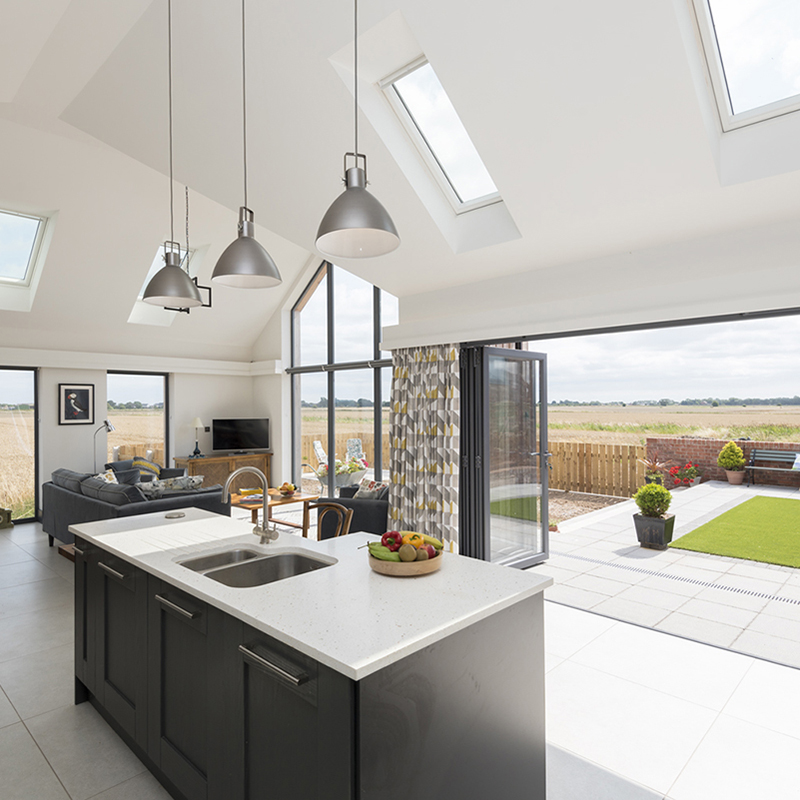Ben Brocklesby, Director at Origin, discusses how the aluminium door and window manufacturer has responded to the latest changes to Part L of the Building Regulations.
In association with![]()
June marked the highly anticipated introduction of the Part L changes to the Building Regulations. This is the next step in the move towards the Future Homes Standard, a plan designed to improve the energy efficiency of UK homes. The new regulations require a 31 per cent reduction in carbon emissions for all new properties, and a 27 per cent cut for non-domestic buildings, such as retail spaces and offices, compared to previous standards.
The calculations used to determine this reduction take several factors into account, including the efficiency of the building’s heating system and electricity use. To help achieve these strict new thresholds, the regulation includes updated minimum efficiency standards for both new and replacement doors and windows.
This is measured using U-values, which indicate how easily heat is transferred through a material. The lower the U-value number, the more thermally efficient a product or material is. Prior to the rules changing, U-values had to meet a notional target of 1.4 W/m²K for windows and glazed doors in new homes, and 1.0 W/m²K for panelled doors. Under the Part L 2022 changes, these notional targets have been reduced to 1.2 W/m²K for windows and glazed doors, which is a considerable drop. Limiting values, the maximum U-values allowable, have also been significantly reduced from 2.0 W/m²K down to 1.6 W/m²K. This is a significant change and has caused challenges for many manufacturers across the country.
At Origin, we work closely with construction professionals every day and understand that architects, specifiers, and builders have been under increasing pressure to make environmentally conscious decisions for several years now. As a result, we are constantly innovating to ensure our products are as thermally efficient as possible. This meant that many of our products were already compliant with the new standards, with no changes required. In fact, our OW-80 Premium Window achieves an ultra-low U-value of 0.8 W/m²K when combining triple-glazing and the industry-leading Aerogel inside the thermal break. This means its performance far exceeds the new Part L requirements.
For those doors and windows that did need updating, our biggest challenge was to adapt the products to reach the new regulations without altering the look, functionality or quality for which Origin is synonymous with, all while minimising cost. It would have been easy for us to simply revert to triple-glazing as standard. However, this wasn’t an option for. Triple-glazing is much heavier, making doors and windows harder to transport, and install and can be more difficult for homeowners to operate during day-to-day life. Plus, it’s more expensive, meaning there would have been a significant cost implication for our customers and subsequent homeowners.
Instead, our R&D team undertook the challenging task of modifying our products on the inside whilst maintaining the signature look and feel of our doors and windows. We did this by insulating critical chambers in our bi-folds and residential doors to improve thermal efficiency.
Like so many other businesses in the industry, we did all this whilst grappling with the rapid cost inflation of raw materials and ongoing challenges within the supply chain. The thermal upgrades we’ve introduced inevitably come with a small price increase, but we are proud to have kept costs to an absolute minimum, particularly given the climate we are operating within.
As we approach the Future Homes Standard’s ultimate goal of ensuring all new homes are carbon neutral by 2025, additional changes will inevitably be required in order to reach this ambitious target. So, rather than take a break, we are now shifting our focus to further innovation to ensure that our products not only meet, but exceed regulations, giving architects, house builders, and homeowners complete reassurance that our products are market-leading and future proofed.
Contact Details
To find out more about Origin doors and windows, visit origin-global.com
Source: Architecture Today






